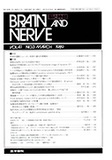Japanese
English
- 有料閲覧
- Abstract 文献概要
- 1ページ目 Look Inside
抄録 被殻出血21例の血腫の大きさ,進展部位による失語像を分析検討した。加えて別報の視床出血例との比較を行ないその相違について検討した。その結果,被殻限局例では,失語症は生じないものがほとんどで出現しても一過性であり,被殻が言語活動に直接関与していないことが示唆された。被殻周辺白質にほぼ限局した中等度血腫例では,表出,受容面共に軽度な低下がみられた混合型失語が多く予後も良好であり,その失語像は視床出血例に極めて類似していた。大血腫例では,前方進展例で表出型,後方進展例で受容型,前後方進展例で全失語の傾向を示し,血腫の大きい症例ほど予後は不良であった。被殻および視床出血でみられた失語症状は,血腫が比較的小さいものであれば,症候学的にいずれも同じような皮質下失語の性状を呈しており,いわゆる線条体失語や視床性失語と呼ばれる程両者に特異性は認められなかった。
Aphasia was evaluated in 21 right-handed pa-tients (39-74 years old) with putaminal hemor-rhage, and compared with that caused by thalamic hemorrhage. The patients were divided into three groups by the volume of the hematoma : small he-matoma (I, n=6), middle hematoma (II, n=8) and large hematoma (III, n=7) groups in computed to-mographic findings. Aphasia examination was per-formed 8-37 days (mean 21 days) after the onset.
In group I, aphasia was not seen or just transient, if any. In group II, aphasia was mainly a mixed type, and the prognosis was excellent in many pa-tients. In group there were expressive type at anterior lesion, receptive type at posterior lesion and global aphasia at anterior-posterior lesion, and the prognosis was not good.
It is suggested that the putamen itself does not participate in language behavior, and that aphasia caused by putaminal hemorrhage is due to destruc-tion of the surrounding tissue of the putamen. The type of aphasia and prognosis are varied by the site of a lesion and a hematoma volume. It is also suggested that the thalamus is related to lan-guage behavior in a circle of thalamus-cortical lan-guage area-thalamus. Aphasia caused by putaminal or thalamic hemorrhage was observed to be dif-ferent from classical cortical aphasia. But there was no significant difference between aphasia caused by putaminal lesions and that by thalamic lesions.

Copyright © 1989, Igaku-Shoin Ltd. All rights reserved.


